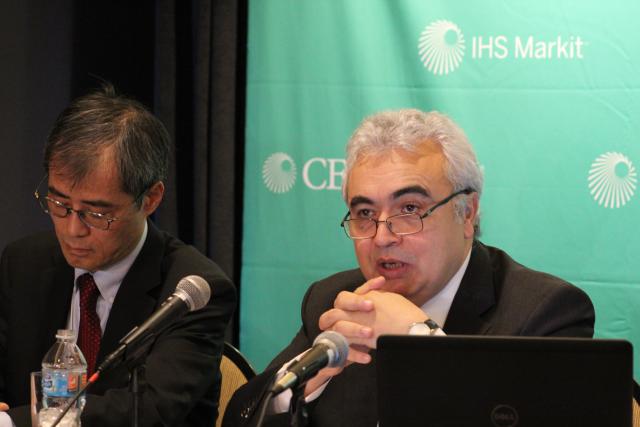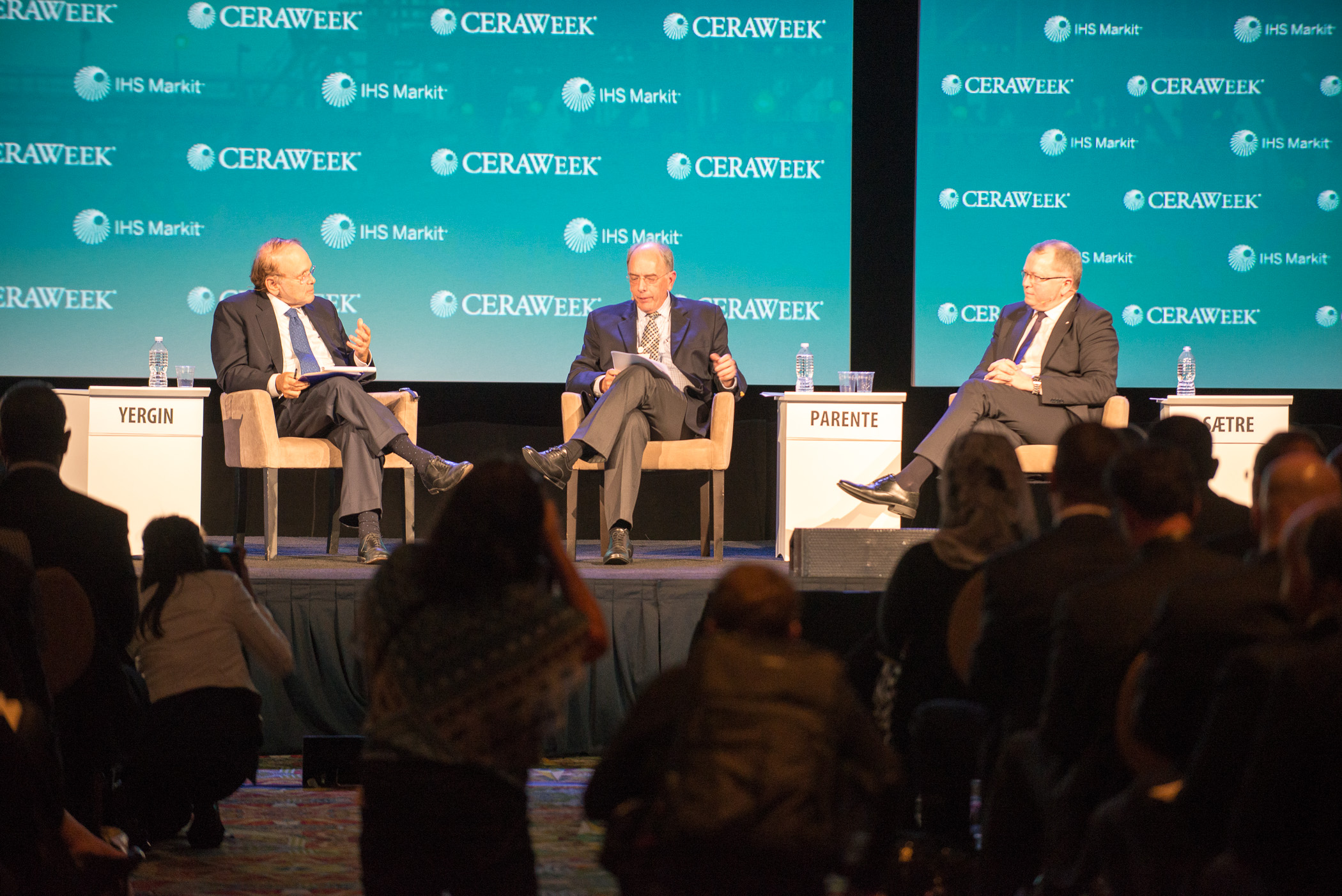
Fatih Birol, executive director of the IEA, discusses the agency’s forecast at CERAWeek in Houston. (Source: Hart Energy)
A “second wave” of U.S. shale oil growth that will bump U.S. light oil production by 1.4 MMbbl/d won’t be enough to meet rising global demand without significant investment, the International Energy Agency (IEA) said in its “Oil 2017” report. That could lead to another round of price volatility, the agency said.
U.S. production growth will depend on price, Fatih Birol, executive director of the IEA, said on March 6 at the conference where the organization released the report, formerly known as the “Medium-term Oil Market Report.”
“Between now and 2022 we may see an expansion of three million barrels per day coming from the U.S.,” Birol said, referring to the report’s high estimate if the price of Brent crude reaches $80/bbl. A price of $60/bbl would result in a U.S. production increase of 1.4 MMbbl/d.
In addition to the U.S., Canada and Brazil also will lead supply growth of 5.6 MMbbl/d by 2022. Demand growth, led by China and India, will grow by 7.3 MMbbl/ d by that time and eclipse 100 MMbbl/d by 2019 on its way to 104 MMbbl/d by 2022.
The IEA’s concern, Birol said, is that production won’t keep up as upstream investment continues to decline. And unlike some in the industry, the IEA does not foresee peak oil demand over the short and medium terms. “The first signals we get from the oil companies are not very encouraging in terms of seeing a strong rebound in investments,” he said. “This comes after two years of substantial declines in upstream investments.”
The decline in investment means more reliance on spare oil production capacity, but that capacity is on track to reach a 14-year low by 2022 based on current trends. Cutbacks in upstream capital investment fell in 2016 for the second year in a row.
Birol compared the forecast for 2022 to the high prices experienced in 2008, when spare production capacity was 4%. The IEA’s projections are that spare capacity will be only 2% in 2022.
The IEA estimated that global upstream investments will be about $450 billion in 2017, or about 25% less than what the agency has projected will meet demand growth and counter declines in existing fields. Birol said the IEA would be more comfortable with a 20% increase in investment.
He also said he supported increased investment in all oil-producing countries, “but the difference between the United States and many others is the U.S. can respond to the higher prices much faster than the others. In other countries, if you were to make an investment today for a field, it would take a lot of time to see the products coming to the markets.”
Increased fuel efficiencies in automobiles and the growing fleet of electric cars will not head off a tightening of the market, he said. “The growth in oil demand globally mainly comes from trucks, jets and petrochemicals,” Birol said. “There it is difficult to find substitutes for oil for now. Today, one-third of oil demand growth comes from Asian trucks.”
Challenges
Recognizing the oil and gas industry’s need to respond to climate change and emissions, Statoil CEO Eldar Sætre said the company plans to allocate about 15% to 20% of its capex to renewables by 2030 if the projects are attractive.
The company is among the world’s leaders in offshore wind energy and carbon capture and storage. Speaking to a crowd gathered on opening day at CERAWeek, Sætre said renewable energy costs are falling amid rapid technology innovation. The company believes renewables, which is the fastest growing source of new power generation capacity, will become cost-competitive without subsidies, Sætre said.
“We all know that oil and gas will continue to be a significant mix of the energy mix for decades to come; however, we have to respond more forcibly to the challenges of climate change, reducing CO2 and methane emissions,” he said, noting this will come with a cost but added that companies who address such challenges will have a competitive advantage.
Sætre was joined on stage by Petrobras CEO Pedro Parente. The two took part in a discussion moderated by IHS Markit Vice Chairman Daniel Yergin on leadership. Each has served in their CEO roles for less than three years and, like many executives, both have faced challenges.

Yergin pointed out how Parente, who was appointed CEO of Petrobras in May 2016, was charged with the “urgent task of restoring confidence in the company and repairing its finances after being forced to write off billions of dollars,” the result of a fallout from a corruption scandal uncovered by an investigation called Operation Car Wash.
Parente stressed that the company and most of its employees were “victims of this corruption scheme, not an agent, no benefit whatsoever,” only huge financial losses. Since the beginning of 2015 the situation has changed for Petrobras, which has worked to reduce its debt by carrying out a more than $15 billion divestment program.
“The fact that our company moved in the newspapers from the scandal page to the business page is very good, but it’s important to stress that this is just the beginning of long work,” he said. “We appreciate the recognition but also are humbled by the responsibility and the challenges that are ahead of us. We will recover credibility as we deliver the results that we promise. That is pretty much what we are doing now.”
These challenges for Petrobras came along with the added obstacles of coping with a recession as well as fiscal imbalances and reforms, including freeing itself from requirements to serve as operator of all of the country’s presalt acreage. And then there was the downturn.
In this regard Sætre and Parente faced similar challenges as major oil and gas players with global assets both onshore and offshore.
Sætre became head of Statoil in mid-October 2014, just before the oil price crash changed life for the oil industry. At the time Sætre remembered the price for a barrel of oil being $90, and then the price collapsed, serving as another reminder that the industry is cyclical, he said. Although the last few years have been challenging, he recalled the saying: “You should never ever waste a good crisis.”
Statoil has reset the cost base, reworking solutions and increasing efficiency from reservoirs to the market, he said. Breakeven costs for Statoil’s so-called next-generation portfolio—which includes projects such as the North Sea’s Johan Sverdrup and Oseberg Vestflanken, Johan Castberg in the Barents Sea, Peregrino II offshore Brazil and Trestakk in the Norwegian Sea with anticipated startups by 2022—went from more than $70/bbl to less than $30/bbl.
“Turns out we are capable of both thinking and acting low-cost when we have to; however, to meet the ultimate test of our ability to learn lies not in the crisis itself but in the recovery. Now is not the time to relax and repeat our mistakes from the past. Now is the time to fundamentally change how we run this industry.”
Recommended Reading
Cella Mixes Two Approaches to Keep CO2 Solidly Underground
2025-04-01 - Cella, a startup in partnership with Halliburton, injects CO2 into basaltic reservoirs, where it reacts and hardens.
Google, SLB, Project Innerspace Form Geothermal Partnership
2025-03-06 - The geothermal partnership between Google Cloud, SLB and Project Innerspace takes shape as energy demand surges, driven in the U.S. by data center growth, the rise of electrification and an increase in manufacturing activity.
California Resources Continues to Curb Emissions, This Time Using CCS for Cement
2025-03-04 - California Resources’ carbon management business Carbon TerraVault plans to break ground on its first CCS project in second-quarter 2025.
Oil & Gas, Geothermal Technology Transfer Not a One-Way Street
2025-03-19 - Technologies commonly used in oil and gas are making it cheaper to drill deep into hot reservoirs to generate geothermal power, but the oil sector could also learn from geothermal, panelists say.
Tallgrass Secures Rights of Way for Green Plains’ Trailblazer CCS Project
2025-01-16 - Green Plains’ Trailblazer project will transport captured biogenic CO2 from a number of Nebraska ethanol facilities to sequestration wells in Wyoming.
Comments
Add new comment
This conversation is moderated according to Hart Energy community rules. Please read the rules before joining the discussion. If you’re experiencing any technical problems, please contact our customer care team.







